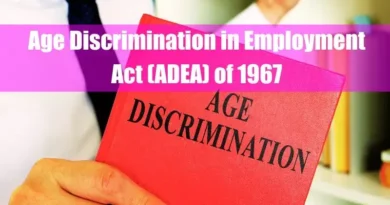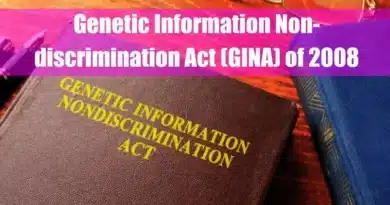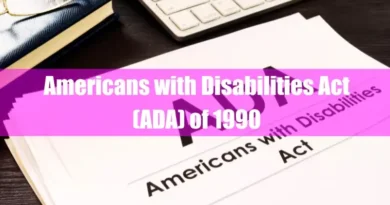Title IX of the Education Amendments of 1972
Takeaways
| Key Points |
|---|
| Title IX prohibits sex-based discrimination in education, encompassing gender identity, sexual orientation, pregnancy, and parenting status, with institutions at risk of losing federal funding if noncompliant. |
| Over time, its scope has expanded, influenced by rulings like Bostock v. Clayton County, which extended protections to LGBTQ+ individuals. |
| While exemptions exist for religious institutions, military schools, and historically single-sex colleges, Title IX broadly applies to federally funded educational programs, enforced by the Office for Civil Rights (O.C.R.), which investigates complaints and ensures compliance through guidance and enforcement actions. |
| Athletic programs are subject to gender equity requirements, assessed using a three-part test, ensuring proportionality, expansion opportunities, or interest accommodation. |
| Sexual harassment, defined as severe and pervasive conduct, is also prohibited, with institutions required to provide grievance procedures that balance survivor protections and due process for the accused. |
| Recent regulatory updates have sparked debate, particularly in addressing harassment, LGBTQ+ rights, and the inclusion of transgender athletes. |
| Finally, Title IX mandates protections for pregnant and parenting students, requiring schools to accommodate their needs without exclusion or additional burdens, reinforcing its commitment to equal educational opportunities. |
Introduction to Title IX
Overview of Title IX
Title IX of the Education Amendments of 1972 is a landmark civil rights law in the United States that prohibits sex-based discrimination in any education program or activity receiving federal financial assistance. The law is codified at 20 U.S.C. § 1681 et seq. Title IX is best known for its impact on high school and collegiate athletics, but its provisions extend far beyond sports, covering all aspects of education, including admissions, financial aid, and academic programs.
Historical Context and Legislative Background
The push for Title IX began in the late 1960s and early 1970s, a period marked by significant social movements advocating for civil rights and gender equality. The catalyst for Title IX was the broader women’s rights movement, highlighting pervasive gender discrimination in education.
Before Title IX, many educational institutions maintained policies that discriminated against women, including denying them admission to certain programs or limiting their participation in certain activities.
Title IX was introduced by Senator Birch Bayh, with significant contributions from Representative Edith Green, who laid much of the groundwork through her earlier legislative efforts. The law was passed by Congress and signed into law by President Richard Nixon on June 23, 1972. It was part of the broader Education Amendments of 1972, which sought to address various issues in the U.S. education system.
Purpose and Scope of Title IX
Title IX’s primary purpose is to eliminate sex-based discrimination in education. The law states: “No person in the United States shall, based on sex, be excluded from participation in, be denied the benefits of, or be subjected to discrimination under any education program or activity receiving Federal financial assistance.”
This broad mandate covers not just athletics but also admissions, recruitment, financial aid, academic programs, housing, and employment within educational institutions.
The scope of Title IX is expansive, applying to all aspects of education that receive federal funds. This includes public and private educational institutions and other entities that receive federal financial assistance for educational programs. Over the years, Title IX has been instrumental in promoting gender equity in education, providing legal recourse for those affected by discrimination, and shaping policies across the educational landscape.

Key Provisions of Title IX
Prohibition of Sex Discrimination
The cornerstone of Title IX is its prohibition of sex-based discrimination in educational programs and activities. This includes “discrimination based on pregnancy, parenting status, sexual orientation, and gender identity, and traditional gender discrimination.” The law requires educational institutions to provide equal opportunities to all students and employees, regardless of sex.
Institutions found violating Title IX can face penalties, including losing federal funding.
Definitions and Interpretations
Over the years, the interpretation of Title IX has evolved to include protections for sexual orientation, gender identity, and intersex traits. The U.S. Department of Education and the Office for Civil Rights (O.C.R.) have issued guidance clarifying that discrimination based on these factors falls under the prohibition of sex discrimination.
This interpretation has been reinforced by legal rulings, such as the Supreme Court’s decision in Bostock v. Clayton County, which extended Title VII protections to cover sexual orientation and gender identity. Although Title IX originally focused on preventing discrimination against women, its scope has expanded to include a broader range of gender-related issues.
Exceptions and Exemptions
While Title IX provides broad protections against sex discrimination, specific exemptions exist. For instance, religious institutions that demonstrate compliance with Title IX would be inconsistent with their religious tenets may be exempt from certain provisions. Similarly, military schools and institutions traditionally serving only one gender are not fully subject to Title IX’s requirements.
Additionally, Title IX does not apply to private undergraduate institutions that have historically and continuously admitted only one sex.

Application and Enforcement of Title IX
Institutions Covered Under Title IX
Title IX applies to various institutions that receive federal financial assistance. This includes most public and private schools, colleges, universities, and other educational institutions. The law covers “traditional educational settings, vocational training programs, museums, libraries, and other educational entities.” Any program or activity operated by these institutions that receives federal funds must comply with Title IX’s provisions.
Role of the U.S. Department of Education and Office for Civil Rights (O.C.R.)
The U.S. Department of Education, through the Office for Civil Rights (O.C.R.), is responsible for enforcing Title IX. The O.C.R. investigates complaints of Title IX violations, conducts compliance reviews, and guides institutions on how to comply with the law. The O.C.R. also offers technical assistance to help institutions understand their obligations under Title IX and to develop policies and procedures that prevent sex discrimination.

Enforcement Mechanisms and Procedures
Title IX enforcement primarily occurs through the O.C.R.’s investigation of complaints. Individuals who believe they have been subjected to sex discrimination in an educational program can file a complaint with the O.C.R. The O.C.R. then investigates the complaint and works with the institution to resolve any violations.
If the institution fails to comply with Title IX, the O.C.R. can initiate enforcement actions, which may include suspending federal funding. Additionally, individuals can file lawsuits under Title IX to seek remedies for discrimination.
Compliance Requirements for Educational Institutions
Educational institutions covered by Title IX must comply with several key requirements. These include developing and implementing non-discrimination policies, designating a Title IX coordinator, and establishing grievance procedures for handling complaints of sex discrimination.
Institutions must also train staff and students on their rights and responsibilities under Title IX. The O.C.R.’s compliance reviews help ensure that institutions are meeting these obligations.

Recent Changes in Enforcement Guidelines
In recent years, there have been significant changes in the enforcement of Title IX. The U.S. Department of Education has issued new regulations that alter how schools must handle allegations of sexual harassment and assault. These changes include a revised definition of sexual harassment, new requirements for grievance procedures, and expanded protections for accused individuals.
The changes have sparked debate over the balance between protecting the rights of survivors and ensuring due process for the accused.
Title IX in Athletics
Gender Equity in Athletic Programs
One of the most well-known applications of Title IX is in athletics. Title IX has been instrumental in promoting gender equity in high school and collegiate sports. The law requires schools to provide equal opportunities for male and female students in athletic programs. This includes equal access to facilities, equipment, coaching, and scholarships.
The Three-Part Test for Assessing Compliance
The O.C.R. uses a three-part test to determine whether an institution complies with Title IX in athletics. The institution must meet at least one of the following criteria: “(1) Provide athletic opportunities that are substantially proportionate to the student enrollment; (2) Demonstrate a history and continuing practice of expanding athletic opportunities for the underrepresented sex; or (3) Fully and effectively accommodate the interests and abilities of the underrepresented sex.” Meeting any one of these criteria is sufficient to demonstrate compliance with Title IX.
Allocation of Resources and Opportunities
Title IX requires equal resources and opportunities between male and female athletic programs. This includes funding, facilities, coaching, and access to competitive opportunities. While Title IX does not require identical spending on men’s and women’s sports, it does require that the allocation of resources be fair and that any disparities be justified by legitimate factors unrelated to gender.
Case Studies and Precedent-Setting Legal Cases
Over the years, several legal cases have shaped the interpretation and enforcement of Title IX in athletics. For example, Cohen v. Brown University (1996) reaffirmed the importance of gender equity in athletics and the use of the three-part test to assess compliance. These cases have set important precedents that continue to influence how Title IX is applied in the context of athletic programs.

Title IX and Sexual Harassment
Definition and Scope of Sexual Harassment Under Title IX
Sexual harassment is a form of sex discrimination prohibited by Title IX. The law defines sexual harassment as unwelcome conduct of a sexual nature, which can include “sexual advances, requests for sexual favors, and other verbal or physical conduct of a sexual nature.”
To be actionable under Title IX, the harassment must be so severe, pervasive, and objectively offensive that it denies the victim equal access to education.
The Evolution of Policy Guidelines
Title IX policy guidelines regarding sexual harassment have evolved significantly over time. Early guidance focused on educational institutions’ responsibilities to prevent and address sexual harassment. Recent changes have expanded the definition of sexual harassment and imposed new procedural requirements on schools.
These changes aim to protect the rights of both survivors and accused individuals while ensuring a fair and equitable process for resolving complaints.
Institutional Responsibilities and Obligations
Educational institutions must respond promptly and effectively to reports of sexual harassment. This includes conducting thorough and impartial investigations, providing supportive measures to survivors, and taking appropriate disciplinary action against perpetrators.
Institutions must also ensure that their policies and procedures comply with Title IX’s requirements and that all school community members are informed of their rights and responsibilities under the law.
Grievance Procedures and Due Process
Title IX requires institutions to establish grievance procedures for handling sexual harassment complaints. These procedures must be fair and impartial, allowing both parties to present evidence and respond to allegations.
Recent regulatory changes have introduced new due process protections for the accused, including the right to cross-examine witnesses and the requirement for a live hearing in certain cases.
These changes aim to balance the rights of survivors with the need for a fair and just process.
Impact of Recent Legal and Regulatory Changes
Recent changes to Title IX regulations have had a significant impact on how schools handle sexual harassment cases. These changes have sparked debate over the balance between protecting survivors and ensuring due process for the accused. While some argue that the new regulations provide necessary protections for the accused, others believe that they may discourage survivors from coming forward.
The ongoing evolution of Title IX policy reflects the complexity of addressing sexual harassment issues under Title IX.

Title IX and LGBTQ+ Protections
Expanding Definitions to Include Sexual Orientation and Gender Identity
Title IX has been increasingly interpreted to protect LGBTQ+ students, particularly in recent years. Initially, the law did not explicitly cover issues related to sexual orientation or gender identity. However, court rulings and federal guidance have expanded the scope of Title IX to include protections against discrimination based on these characteristics.
The 2020 Supreme Court decision in Bostock v. Clayton County was a turning point, as the Court ruled that Title VII of the Civil Rights Act, which prohibits sex discrimination in employment, also applies to discrimination based on sexual orientation and gender identity. This ruling has influenced Title IX interpretations, suggesting that discrimination against LGBTQ+ students is a form of sex discrimination prohibited under the law.
Legal Precedents and Court Rulings
Several key legal cases have clarified Title IX’s application to LGBTQ+ issues. For instance, in Grimm v. Gloucester County School Board (2020), the Fourth Circuit Court of Appeals upheld the rights of a transgender student to use restrooms consistent with their gender identity, finding that the school board’s policy violated both Title IX and the Equal Protection Clause. Similarly, the Seventh Circuit’s decision in Whitaker v. Kenosha Unified School District (2017) also supported the rights of transgender students under Title IX, emphasizing that discrimination based on gender identity is inherently sex-based discrimination.
Current Challenges and Debates
Despite these advances, the application of Title IX to LGBTQ+ protections remains a contentious issue. Some states have passed laws or policies that conflict with federal interpretations of Title IX, particularly regarding transgender students’ participation in sports or access to facilities.
These conflicts have led to ongoing legal battles and debates over the extent of Title IX’s protections. Advocates argue for the importance of upholding these protections to ensure that LGBTQ+ students have equal access to educational opportunities without fear of discrimination or harassment.
Institutional Best Practices for Inclusivity
Educational institutions are encouraged to adopt inclusive policies that respect the rights of LGBTQ+ students under Title IX. Best practices include updating anti-discrimination policies to explicitly include sexual orientation and gender identity, providing training for staff and students on LGBTQ+ issues, and ensuring that facilities and programs are accessible to all students regardless of gender identity. Institutions should also establish clear procedures for addressing complaints of discrimination or harassment against LGBTQ+ students, ensuring a safe and supportive environment for all.
Title IX and Pregnant and Parenting Students
Rights and Protections Under Title IX
Title IX also extends protections to pregnant and parenting students, ensuring they are not discriminated against in educational programs and activities. The law prohibits schools from excluding pregnant students from participating in classes, extracurricular activities, or sports.
Schools are also required to provide reasonable adjustments, such as allowing more frequent bathroom breaks or providing access to elevators, to accommodate the needs of pregnant students.
Institutional Responsibilities
Educational institutions must take steps to support pregnant and parenting students and ensure they have equal access to educational opportunities. This includes providing access to academic support services, offering flexible scheduling or online learning options, and allowing students to make up missed work due to pregnancy or childbirth-related absences. Schools are also prohibited from pressuring students to attend alternative programs or schools for pregnant students if they prefer to remain in their regular educational setting.
Recent Regulatory Updates
Recent updates to Title IX regulations have reinforced the rights of pregnant and parenting students. The U.S. Department of Education has issued guidance emphasizing the need for schools to adopt non-discriminatory policies and practices that support these students.
This includes ensuring that schools do not impose additional burdens on pregnant students, such as requiring them to obtain medical certification unless it is required of all students with physical or emotional conditions.

Notable Title IX Cases and Legal Precedents
Landmark Cases in Title IX Jurisprudence
Title IX’s impact has been shaped by several landmark legal cases that have clarified the law’s application and scope. One of the most significant cases is Grove City College v. Bell (1984), in which the Supreme Court ruled that Title IX applied only to specific programs within an institution that received federal funding. The Civil Rights Restoration Act of 1987 later overturned this narrow interpretation, which restored Title IX’s broader application to entire institutions if any part received federal funds.
Another important case is Franklin v. Gwinnett County Public Schools (1992), where the Supreme Court held that plaintiffs could seek monetary damages in lawsuits brought under Title IX. This ruling significantly strengthened the enforcement of Title IX, providing a powerful deterrent against sex discrimination.
Impact on the Interpretation and Application of Title IX
These and other cases have shaped how Title IX is interpreted and enforced. The courts have consistently upheld its broad scope, affirming its application to a wide range of issues, including sexual harassment, gender equity in athletics, and discrimination against LGBTQ+ students (Recent legal interpretations and ongoing cases have increasingly recognized that discrimination against LGBTQ+ students may also fall under Title IX’s protections).
These legal precedents have reinforced Title IX’s role as a vital tool for promoting gender equality in education.
Recent Court Decisions
In recent years, courts have continued to address the evolving application of Title IX. Cases such as Doe v. University of Kentucky (2021) have explored the balance between Title IX protections and due process rights, highlighting ongoing debates over how to adjudicate sexual misconduct allegations fairly. These decisions reflect the complexities of enforcing Title IX in a rapidly changing legal and social landscape.
Challenges and Controversies Surrounding Title IX
Criticisms of Title IX Implementation
While Title IX has been instrumental in advancing gender equity, its implementation has been challenging. Critics argue that the law’s broad scope can lead to inconsistent enforcement and that some institutions may struggle to comply with its requirements.
Additionally, there have been concerns about the fairness of Title IX procedures, particularly in cases of sexual misconduct, where some argue that the rights of accused individuals may be compromised.
Debates Over Due Process Rights in Sexual Misconduct Cases
One of the most contentious issues surrounding Title IX is the balance between protecting survivors of sexual misconduct and ensuring due process for the accused. Critics of Title IX enforcement in this area argue that some procedures may be biased against the accused, leading to unfair outcomes.
Recent regulatory changes have sought to address these concerns by strengthening due process protections, including the right to a live hearing and cross-examination in sexual misconduct cases. However, these changes have also sparked debate over whether they might discourage survivors from reporting incidents.
The Impact of Political and Social Changes on Title IX
Title IX has also been influenced by broader political and social changes. Different administrations have taken varying approaches to Title IX enforcement, reflecting shifting priorities and values. For example, the Obama administration issued guidance expanding protections for transgender students under Title IX, while the Trump administration rescinded this guidance and implemented new regulations focusing on due process in sexual misconduct cases.
The ongoing evolution of Title IX reflects the dynamic nature of civil rights law and the challenges of balancing competing interests in a diverse society.

Future of Title IX
Ongoing Legislative and Regulatory Developments
As Title IX approaches its 50th anniversary, efforts are ongoing to refine and improve the law further. Legislative proposals have been introduced to expand Title IX’s protections, including measures to strengthen support for LGBTQ+ students and ensure more robust enforcement of gender equity in athletics.
Additionally, there are ongoing discussions about addressing the challenges of implementing Title IX fairly to all parties involved.
Potential Reforms and Amendments
Potential reforms to Title IX may focus on clarifying the law’s scope and ensuring that it keeps pace with evolving social norms. For example, efforts may be made to codify protections for LGBTQ+ students or address the challenges of enforcing Title IX in online and remote learning environments.
These reforms could help ensure that Title IX remains a powerful tool for promoting gender equality in education.
The Role of Advocacy and Activism in Shaping Title IX
Advocacy and activism have played a key role in shaping Title IX and will continue to do so in the future. Grassroots movements, student organizations, and civil rights groups have been instrumental in pushing for stronger protections under Title IX and holding institutions accountable for violations. As the legal and social landscape evolves, advocacy will remain critical in ensuring that Title IX fulfills its promise of gender equity in education.

Conclusion
Title IX of the Education Amendments of 1972 is a cornerstone of gender equality in education. Over the past five decades, it has transformed the landscape of American education, opening doors for women and girls and providing critical protections against discrimination.
While challenges and controversies remain, Title IX remains a vital tool in the fight for equal rights. As society and the legal landscape evolve, so will the interpretation and application of Title IX, ensuring that it remains relevant and effective in promoting gender equity for all.
FAQ
What is Title IX’s primary purpose?
Title IX aims to eliminate sex-based discrimination in educational programs or activities receiving federal financial assistance, ensuring equal access and opportunities for all students and employees.
Does Title IX apply to private schools?
Title IX applies to private educational institutions that receive federal funding. However, private undergraduate institutions that have historically and continuously admitted only one sex are exempt from Title IX’s requirements.
How does Title IX impact admissions policies?
Title IX prohibits sex-based discrimination in admissions policies of educational institutions receiving federal funds, ensuring equal access for all applicants. However, it does not apply to admissions policies of private undergraduate institutions that have historically and continuously admitted only one sex.
Are single-sex programs allowed under Title IX?
Title IX permits single-sex programs if they meet specific criteria, such as providing substantially equal opportunities for both sexes and serving important educational objectives. Institutions must ensure that participation is voluntary and that comparable programs are available for the excluded sex.
How does Title IX address sexual harassment?
Title IX defines sexual harassment as unwelcome conduct of a sexual nature that is so severe, pervasive, and objectively offensive that it denies a person equal access to education. Institutions must respond promptly and effectively to such conduct to comply with Title IX.
What are the consequences for institutions violating Title IX?
Institutions found in violation of Title IX risk losing federal funding. The Office for Civil Rights (OCR) enforces compliance through investigations and can initiate enforcement actions if necessary.
Does Title IX protect LGBTQ+ students?
Yes, Title IX’s prohibition of sex-based discrimination has been interpreted to include discrimination based on sexual orientation and gender identity, thereby protecting LGBTQ+ students.
How does Title IX affect pregnant and parenting students?
Title IX prohibits discrimination against students based on pregnancy or parenting status. Schools must provide reasonable adjustments and cannot exclude pregnant students from participating in educational programs or activities.
Are there exemptions to Title IX?
Yes, Title IX includes exemptions for religious institutions if compliance conflicts with their religious tenets. Additionally, military schools and institutions traditionally serving only one gender may not be fully subject to Title IX’s requirements.
How can individuals file a Title IX complaint?
Individuals who believe they have experienced sex-based discrimination can file a complaint with the Office for Civil Rights (OCR) within 180 days of the alleged discrimination. The OCR investigates complaints and works with institutions to resolve violations.
Citations
- Title Ix Of The Education Amendments Of 1972. (2015, August 6). https://www.justice.gov/crt/title-ix-education-amendments-1972
- Title IX and Sex Discrimination. (n.d.). https://www2.ed.gov/about/offices/list/ocr/docs/tix_dis.html
- https://www.govinfo.gov/content/pkg/USCODE-2021-title20/pdf/USCODE-2021-title20-chap38.pdf









